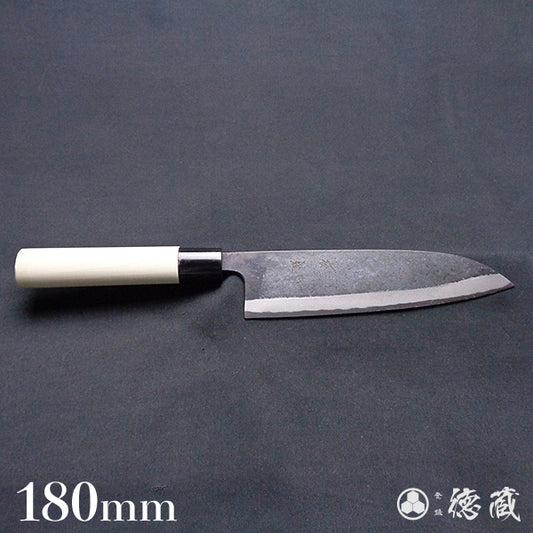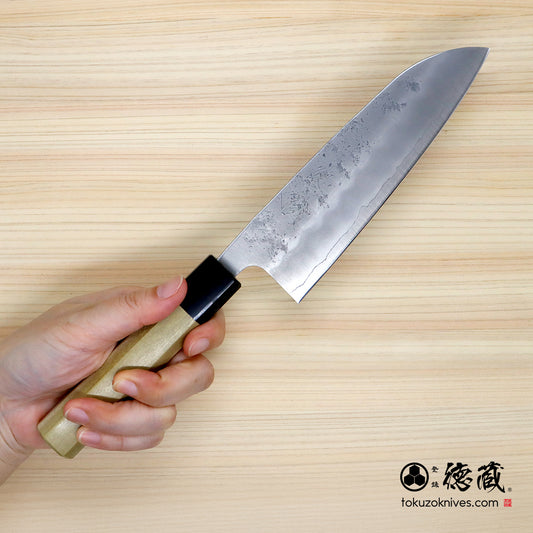Santoku knives are a combination of the features of the Japanese vegitable knife and the western chef's knife.
It is an all-purpose knife that can be used for meat, fish, and vegetables, and is the most popular knife in Japanese households because of its sharp blade tip, which makes it suitable for detailed cooking.
How does Santoku differ from chef's knife?
Santoku knives have a wider body of the knife than chef's knives, and the blade line is nearly straight with a voluminous tip of the blade.
Santoku is recommended for those who like to cook vegetables, as there is little leftover when shredding.
About Chef's knife
Chef's knife is a Western all-purpose kitchen knife widely used throughout the world. It is also called a French knife.
Originally designed for conveniently cutting lumps of meat, the blade width is narrower than that of the santoku knife.
It has a pointed tip, which makes it easy to insert the cutting edge when cutting meat, and also makes it easy to remove the fiber. It is also suitable for those who push and pull cuts in a circular motion due to the curved line of the blade tip.
usage of all-purpose knife (Santoku, Gyuto)
Santoku is an all-purpose knife and can be used for a variety of foods.
- Carving meat
- Cutting up fish
- Preparing meat and fish by cutting into them.
- Cutting large leafy vegetables such as lettuce and cabbage
- Cutting up takuan (radish pickles), cucumbers, etc. without leaving any residue.
- Preparing meat and fish by cutting into pieces (same as above?)
- Peeling fruits and daikon radish
Our bland selection
List of blands Tokuzo Knives offers
Tokuzo - House Brand
Original brand products made in cooperation with local knife craftsmen and manufacturers.
We select the best blacksmith, who makes the base of the knife, sharpener, who makes the knife's makeup, and handle maker by steel material and shape. Our knives are characterized by their practicality and high quality. A wide range of products for use by professional cooks and for home use.
Yondaime Ishizuchi Tomika
A brand of Tosa-uchi kitchen knives with a history of more than 100 years. The company produces practical and cost-effective kitchen knives, mainly double-edged blacksmith-finish knives, bearing the name of Mt. Ishizuchi, the highest peak in Western Japan.
Tadokoro Cutlery
At the age of 16, Mr. Tadokoro entered the kitchen knife industry and established his own business, Tosa Kitchen Knife Studio Tadokoro Cutlery, in 2010.
He established his own brand ""Marushin"" in Sakai City, Osaka, the home of cutlery, after training under the top sharpeners in Sakai city, home of knives.
He has been a sharpener for more than 29 years, and his skills, which have been passed down as Japanese tradition, are highly regarded in the industry both at home and abroad.
His skills are highly appreciated by big-name Japanese knife craftmen and chefs, and he has received numerous requests from both domestic and overseas customers, and continues to work hard every day to improve his craft. His knives are characterized by their gorgeous and detailed workmanship, which is highly regarded around the world.
Naoto Myojin
Naoto Myojin is the second generation Knife sharpener at Myojin Toshiki Seisakusho in Susaki City, Kochi Prefecture.
He learned blacksmith work for three years from the age of 18, then switched to a sharpener. He learned sharpening under his father, the founder of their business, and later spent several years in Fukui Prefecture for training in sharpening. There, he learned to sharpen ""Hamaguriba"" (clam blades). After that, with his natural curiosity and energy, he continued to visit sharpeners all over the country to exchange techniques and learn new technologies.
He continues to improve upon feedback from users, and his relentless ambition to improve upon it has allowed him to continue to grow and refine his skills and variations at an astonishing speed.
The knives are sharpened by carefully adjusting the thickness of the blade, making it slightly rounded toward the edge, but not too thin.
The knives are highly regarded not only in Japan but also abroad for their excellent bite and sharpness. This is a high-quality product that you should definitely try.
Selection by materials
Stainless steel (for those who value ease of handling)
The most common material for household knives.
It is sharp and rust-resistant, so it is recommended for those who seek both sharpness and ease of handling, as well as for beginners in cooking.
It is more difficult to sharpen than carbon steel because of the difference in compatibility with sharpening stones.
Carbon steel (for those seeking sharpness)
Recommended for those who seek sharpness.
It reasily rust if soaked in water, which is more troublesome than stainless steel. However, when sharpened with a whetstone, the original flavor of the food can be easily conveyed.
It is also recommended for first-time knife sharpeners as it works well with a whetstone.
Damascus steel (both decorative and strong)
Highly decorative and expensive. Because it is made by layering dozens of different metals, a different rippled pattern appears on the surface of each piece of steel.
They are also rust-resistant, sharp and durable.
Recommended for those who are particular about appearance and performance, and who want a highly decorative and professional product even if it costs more.
Stainless-clad steel (hybrid type)
A material that combines the sharpness of steel with the rust resistance of stainless steel.
The structure is a three-layer sandwich, with steel as the first part to come into contact with food (core) and stainless steel on the outside, providing excellent rust resistance, sharpness, and durability.
Recommended for those who want sharpness, but also value ease of maintenance.
Selection by blade lenth and weight
Blade length
The most common santoku size is roughly 15-18 cm.
The blade length should be considered based on the knife you are currently using.
If you are using a small cutting board or cutting only small foods, a smaller knife is recommended.
Also, the longer the blade length, the thicker the grip tends to be.
Weight
The standard weight of a Western-style handle knife is around 150g.
Since most models have the center of gravity in the handle, the actual weight depends on how you grip it. It is recommended to choose one that is neither too light nor too heavy.
If it is too light, it will lose stability or require extra strength when cutting, but if it is too heavy, your hand will get tired. Try to hold a knife at a knife shop and check the weight.
Selection by handle type
Handles are divided into two types: replaceable Japanese handles used for Japanese kitchen knives and Western handles used for Western kitchen knives.
The cross-sectional shape of a Japanese handle can be rounded, octagonal and so on. The shape of the handle is a matter of preference, as it determines the comfort of the grip.
Western handles have shorter handles than Japanese handles, and some have a barb at the end of the handle.
Selection by handle material
Natural wood
A material with the feeling of warmth of nature.
It fits easily in the hand and is comfortable to hold.
It is especially important to wipe it dry after cooking for long use.
For knives with Japanese handles, the most common type is magnolia wood. Other species include walnut and zelkova, which are slightly harder and darker in color. For high-end or decorative knives, ichii, close grain, ebony, and black ebony are also used.
Laminated wood
This type of wood is often used for Western-style knives and is more durable than natural wood because it is manufactured under pressure. Although it is made of wood, it is harder than solid wood, so it takes time for the hand to get used to it.
Resin / Pom
A wide variety of designs and colors are available. Resistant to water and non-corrosive, and easy to clean.
Some of them are dishwasher-safe, but we do not recommend using them.
*If a strong stream of water hits the knife during washing, the cutting edge may come in contact with the basket and cause damage.
Stainless steel
Many products are seamless, which makes them hygienic and prevents dirt.
Many have a simple design, and the uneven handles provide a better grip, making it possible to use them with confidence even when cooking with a lot of force.
Some of them are dishwasher-safe, but we do not recommend using them.
*If a strong stream of water hits the knife during washing, the cutting edge will come in contact with the basket.











